人教版(2019)必修第一册Unit4 Natural disasters 限制性与非限制性定语从句的区别课件(12张ppt)
文档属性
| 名称 | 人教版(2019)必修第一册Unit4 Natural disasters 限制性与非限制性定语从句的区别课件(12张ppt) |
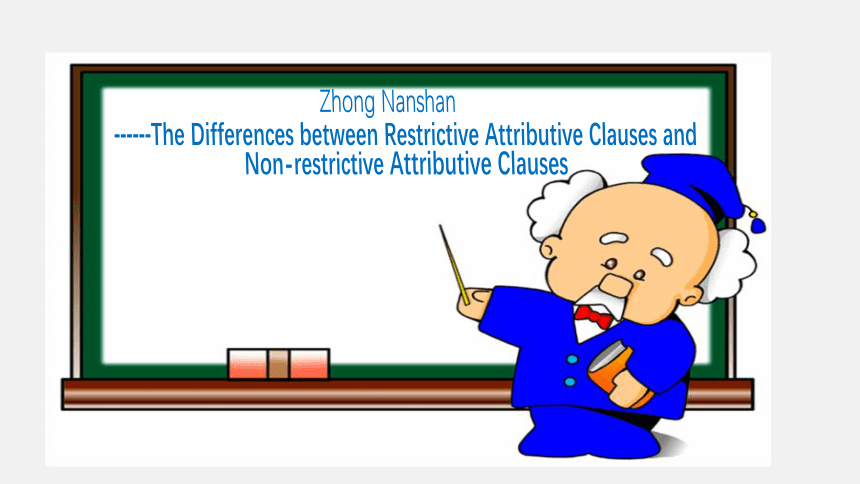
|
|
| 格式 | zip | ||
| 文件大小 | 1.1MB | ||
| 资源类型 | 教案 | ||
| 版本资源 | 人教版(2019) | ||
| 科目 | 英语 | ||
| 更新时间 | 2023-01-12 14:57:53 | ||
图片预览

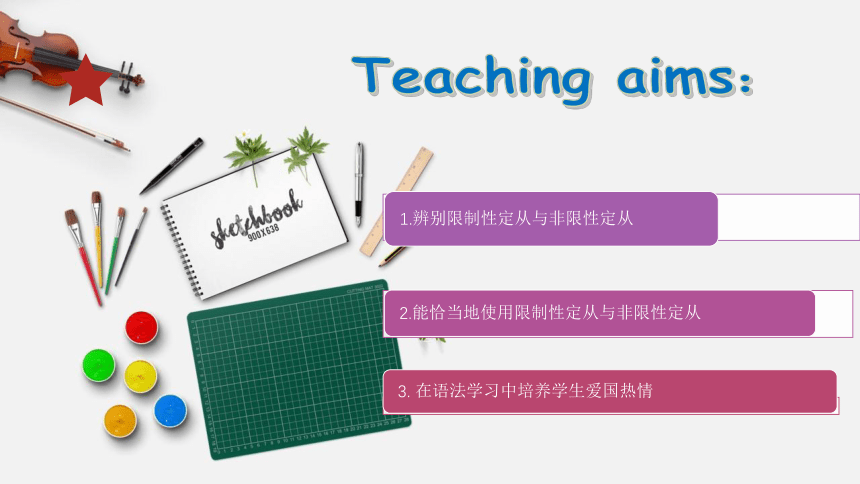
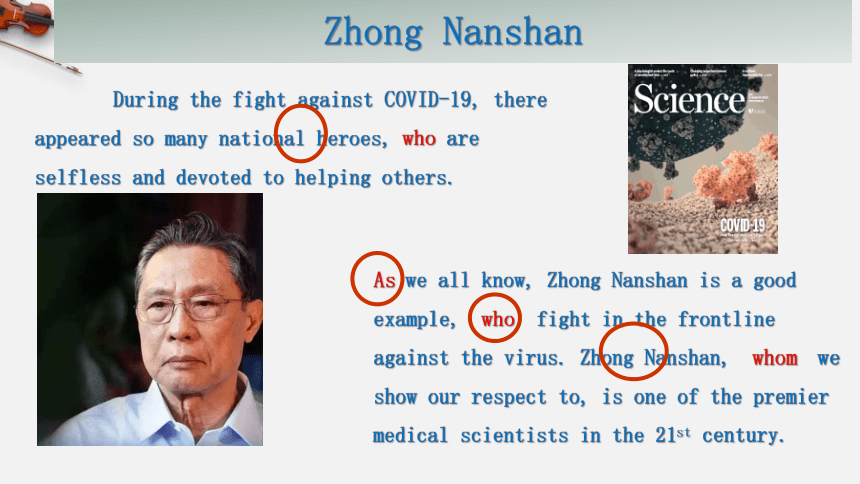
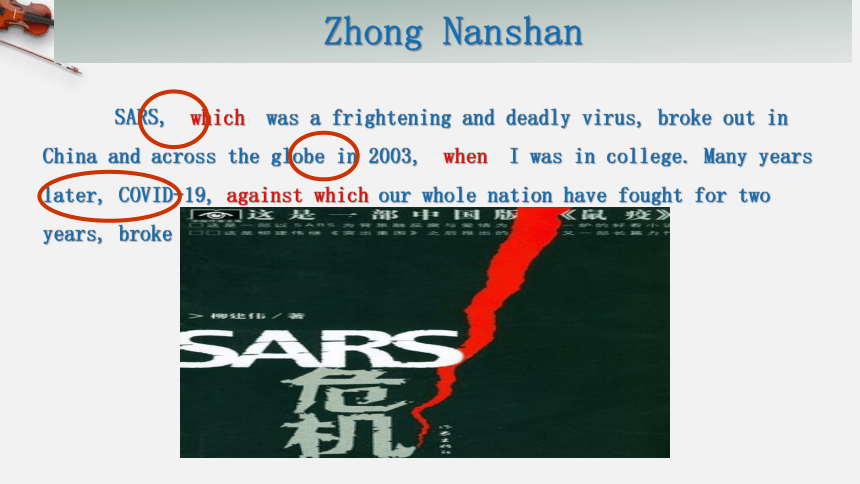
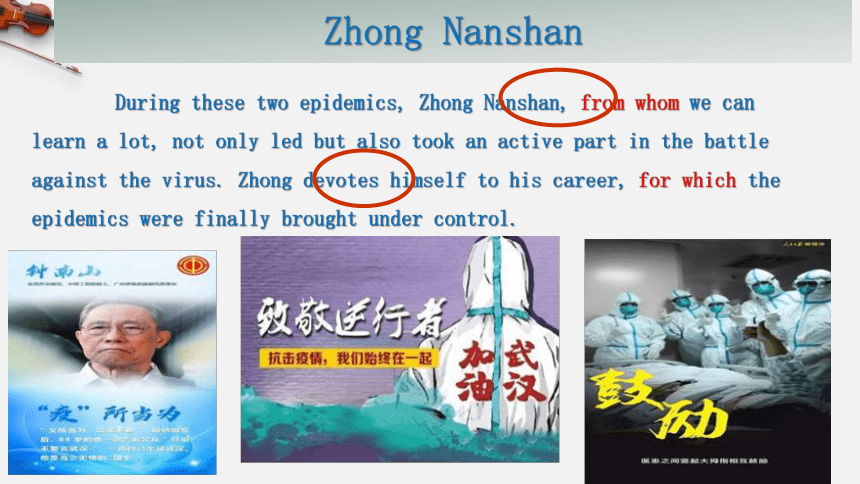
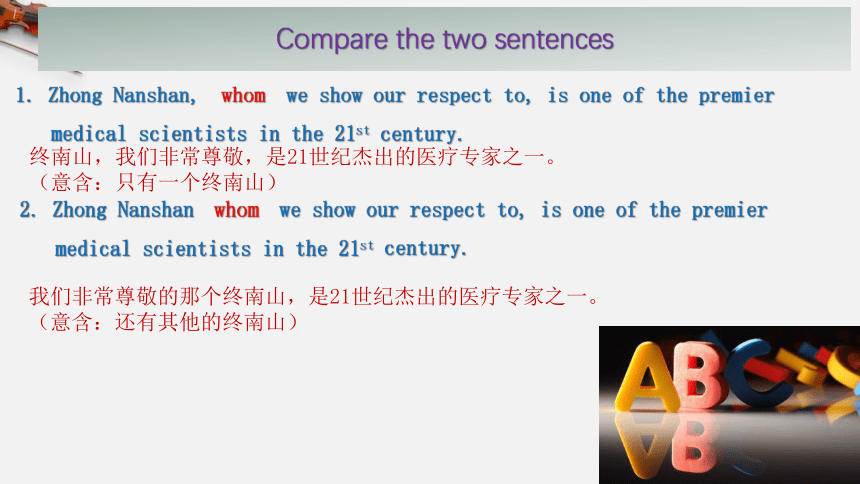
文档简介
(共12张PPT)
Zhong Nanshan
------The Differences between Restrictive Attributive Clauses and
Non-restrictive Attributive Clauses
Teaching aims:
Zhong Nanshan
During the fight against COVID-19, there appeared so many national heroes, who are selfless and devoted to helping others.
As we all know, Zhong Nanshan is a good example, who fight in the frontline against the virus. Zhong Nanshan, whom we show our respect to, is one of the premier medical scientists in the 21st century.
SARS, which was a frightening and deadly virus, broke out in China and across the globe in 2003, when I was in college. Many years later, COVID-19, against which our whole nation have fought for two years, broke out first in Wuhan.
Zhong Nanshan
During these two epidemics, Zhong Nanshan, from whom we can learn a lot, not only led but also took an active part in the battle against the virus. Zhong devotes himself to his career, for which the epidemics were finally brought under control.
Zhong Nanshan
1. Zhong Nanshan, whom we show our respect to, is one of the premier medical scientists in the 21st century.
Compare the two sentences
终南山,我们非常尊敬,是21世纪杰出的医疗专家之一。
(意含:只有一个终南山)
2. Zhong Nanshan whom we show our respect to, is one of the premier medical scientists in the 21st century.
我们非常尊敬的那个终南山,是21世纪杰出的医疗专家之一。
(意含:还有其他的终南山)
The restrictive and non-restrictive attributive clause
限制性定语从句 非限制性定语从句
意义 是主句不可或缺的一部分, 若省去, 主句意义不完整, 甚至没有意义 起补充说明作用, 若省去, 主句意义仍完整
结构要求 不用逗号分开 用逗号分开
关系词 可用that代替人或物,作宾语时可省略 不可用that引导,作宾语时不可省略
1. There appeared so many national heroes, who are selfless and devoted to helping others.
The Relatives used in the non-restrictive attributive clauses
非限制性定语从句通常不能用that引导,指人用who, 指物用which。
eg: I like the book, which was bought yesterday.
2. As we all know, Zhong Nanshan is a good example.
非限制性定语从句置于句首时,不能用which引导。关系代词as引导非限制性定语从句位置比较灵活,可以放主句前,也可以放主句后。
eg: Einstein, as is known to us, is a famous scientist.
3. Zhong Nanshan, whom we show our respect to, is one of the premier medical scientists in the 21st century.
在非限制性定语从句中,指人的关系代词作宾语时,只能用宾格whom,不能用who替换,也不能省略。
eg: Do you know Tom, whom we talked about
4. SARS, which was a frightening and deadly virus, broke out in China
在非限制性定语从句中,which可指代先行词,也可指代前面整个句子。
eg: The sun sends out light and heat, which makes it possible for living things to exist on the earth.
The Relatives used in the non-restrictive attributive clauses
5. SARS, which was a frightening and deadly virus, broke out in China and across the globe in 2003, when I was in college.
关系副词when、where也可用在非限制性定语从句中,并且可以用介词+关系代词代替,如when(=in which) I was in college.
The Relatives used in the non-restrictive attributive clauses
6. During these two epidemics, Zhong Nanshan, from whom we can learn a lot, not only led but also took an active part in the battle against the virus.
7. Zhong devotes himself to his career, for which the epidemics were finally brought under control.
非限制性定语从句由“介词+关系代词” 引导时,先行词指人时,介词后用whom, 指物时介词后用which。非限制性定语从句不能用why引导,而要用for which代替why。
非限制性定语从句(non-restrictive attributive Clause)
Summary
1.非限制性定语从句和主句关系不密切,只是对先行词作附加说明,如果去掉,主句的意思仍然完整。
2.非限制性定语从句和主句之间往往用逗号分开,一般不用that和why引导。
3.非限制性定语从句的关系词有:who, whom, as, which, whose, when, where, prep.+which/whom等,其中关系词不可省略。
谢
谢
观
看
Zhong Nanshan
------The Differences between Restrictive Attributive Clauses and
Non-restrictive Attributive Clauses
Teaching aims:
Zhong Nanshan
During the fight against COVID-19, there appeared so many national heroes, who are selfless and devoted to helping others.
As we all know, Zhong Nanshan is a good example, who fight in the frontline against the virus. Zhong Nanshan, whom we show our respect to, is one of the premier medical scientists in the 21st century.
SARS, which was a frightening and deadly virus, broke out in China and across the globe in 2003, when I was in college. Many years later, COVID-19, against which our whole nation have fought for two years, broke out first in Wuhan.
Zhong Nanshan
During these two epidemics, Zhong Nanshan, from whom we can learn a lot, not only led but also took an active part in the battle against the virus. Zhong devotes himself to his career, for which the epidemics were finally brought under control.
Zhong Nanshan
1. Zhong Nanshan, whom we show our respect to, is one of the premier medical scientists in the 21st century.
Compare the two sentences
终南山,我们非常尊敬,是21世纪杰出的医疗专家之一。
(意含:只有一个终南山)
2. Zhong Nanshan whom we show our respect to, is one of the premier medical scientists in the 21st century.
我们非常尊敬的那个终南山,是21世纪杰出的医疗专家之一。
(意含:还有其他的终南山)
The restrictive and non-restrictive attributive clause
限制性定语从句 非限制性定语从句
意义 是主句不可或缺的一部分, 若省去, 主句意义不完整, 甚至没有意义 起补充说明作用, 若省去, 主句意义仍完整
结构要求 不用逗号分开 用逗号分开
关系词 可用that代替人或物,作宾语时可省略 不可用that引导,作宾语时不可省略
1. There appeared so many national heroes, who are selfless and devoted to helping others.
The Relatives used in the non-restrictive attributive clauses
非限制性定语从句通常不能用that引导,指人用who, 指物用which。
eg: I like the book, which was bought yesterday.
2. As we all know, Zhong Nanshan is a good example.
非限制性定语从句置于句首时,不能用which引导。关系代词as引导非限制性定语从句位置比较灵活,可以放主句前,也可以放主句后。
eg: Einstein, as is known to us, is a famous scientist.
3. Zhong Nanshan, whom we show our respect to, is one of the premier medical scientists in the 21st century.
在非限制性定语从句中,指人的关系代词作宾语时,只能用宾格whom,不能用who替换,也不能省略。
eg: Do you know Tom, whom we talked about
4. SARS, which was a frightening and deadly virus, broke out in China
在非限制性定语从句中,which可指代先行词,也可指代前面整个句子。
eg: The sun sends out light and heat, which makes it possible for living things to exist on the earth.
The Relatives used in the non-restrictive attributive clauses
5. SARS, which was a frightening and deadly virus, broke out in China and across the globe in 2003, when I was in college.
关系副词when、where也可用在非限制性定语从句中,并且可以用介词+关系代词代替,如when(=in which) I was in college.
The Relatives used in the non-restrictive attributive clauses
6. During these two epidemics, Zhong Nanshan, from whom we can learn a lot, not only led but also took an active part in the battle against the virus.
7. Zhong devotes himself to his career, for which the epidemics were finally brought under control.
非限制性定语从句由“介词+关系代词” 引导时,先行词指人时,介词后用whom, 指物时介词后用which。非限制性定语从句不能用why引导,而要用for which代替why。
非限制性定语从句(non-restrictive attributive Clause)
Summary
1.非限制性定语从句和主句关系不密切,只是对先行词作附加说明,如果去掉,主句的意思仍然完整。
2.非限制性定语从句和主句之间往往用逗号分开,一般不用that和why引导。
3.非限制性定语从句的关系词有:who, whom, as, which, whose, when, where, prep.+which/whom等,其中关系词不可省略。
谢
谢
观
看
